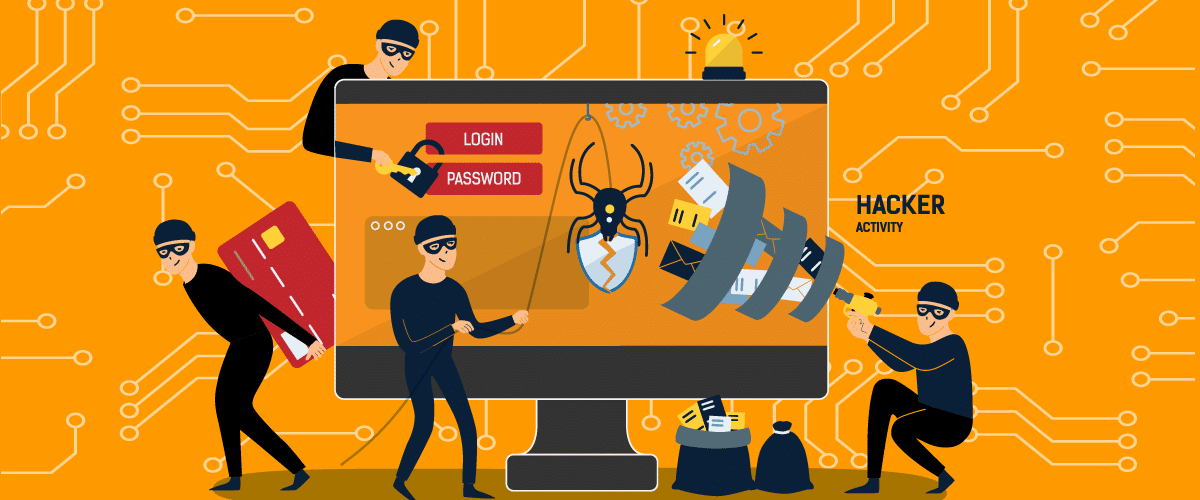
Understanding different kinds of network attacks
1. Introduction
Today’s networks are the primary means of data transmission and communication and, as such, are exposed to various threats that can compromise the privacy and integrity of information.
Cybercriminals use a variety of techniques and tools to exploit different types of attacks on networks and computer systems in order to gain access to sensitive information or cause harm to users and businesses. In this article, we will explore the different types of attacks on a network, so that you can better understand the existing threats and take steps to protect your data and systems.
We will go on to analyze the main types of attacks, from denial-of-service attacks to brute force attacks, and explain how they work, what their targets are, and how to prevent them.
2. Denial of service (DoS) attacks
Denial of Service (DoS) attacks are a common type of network attack that aims to overload the resources of a server or device so that it becomes inaccessible to users. The increase in memory and CPU of network devices due to the number of simultaneous requests is one of the reasons why network devices become inaccessible. These attacks have become increasingly common in recent years and can be very damaging to the companies that are subjected to them.
There are several ways in which attackers can carry out a DoS attack. One of the most common methods is the flood attack, in which the attacker sends a large number of connection requests to a server so that it becomes saturated and cannot respond to legitimate requests. This is achieved by sending a large number of connections, such as SYN -type connections in TCP; in this type of connection, it is normal to send a SYN-ACK response, but this type of attack sends no response, allowing the router or service at the other end to open connections and leave them open and have more and more unanswered connections, causing the service or devices, over time, to become inaccessible due to memory or CPU consumption.
DoS attacks can have serious consequences for businesses, including loss of data or disruption of services. In some cases, DoS attacks can even have economic consequences, as a company with online transaction services would not be able to offer them while experiencing a DoS attack.
One of the most effective measures of preventing a DoS attack is the implementation of intrusion detection and prevention systems (IDS/IPS), which can detect and block DoS attacks before devices become inaccessible.
It is also important to have redundancy or failover systems so that, if one server is hit by a DoS attack, services can continue to run on other servers. In general, it is important to have high-capacity hardware for these attacks.
Also, as end users, you can help prevent DoS attacks by making sure your systems are up-to-date and not running malicious software. A DoS attack can take control of a computer in order to join a botnet and then execute a DDoS (distributed DoS) attack without the user’s knowledge.
>> FlashStart protects you from a vast range of threats and blocks access to dangerous sites → Request a quotation or try it now
3. Phishing attacks
Phishing attacks can take many forms, but they typically involve creating a fake web page or email that looks like a legitimate web page or email, with the intent of tricking the user into revealing personal information or clicking on a malicious link. It is, therefore, important to be vigilant and not trust any web page or email that appears suspicious.
One way to avoid falling victim to a phishing attack is to always verify the web address and sender of the email before entering personal information or clicking on a link. If there is any doubt about the authenticity of an email or web page, it is better to verify it first.
Phishing is a form of social engineering that uses persuasion and manipulation to obtain sensitive information. Cybercriminals can use social engineering techniques to obtain personal information from social networks, such as pet names, dates of birth, etc., and use it to create a personalized phishing message.
Phishing attacks can have serious consequences for users and companies. Users can lose personal and financial information, while companies can lose critical data or experience a security breach.
In order to protect against network phishing attacks, it is important for users to be informed and aware of the techniques used by attackers. Users should be aware that emails or text messages requesting personal or financial information are suspicious and should be verified before responding. It is important that users verify the authenticity of an email message or website before providing personal or financial information.
Companies can also take measures to protect against phishing attacks, such as implementing email security measures, training employees, and implementing strong cybersecurity policies.
FlashStart offers a comprehensive solution for preventing such network attacks and stopping the eventual infection or data theft by cybercriminals.
4. Ransomware attacks
Ransomware attacks are one of the most worrisome cybersecurity threats at the present time. Ransomware attacks are characterized by encrypting the victim’s data and demanding a ransom to unlock it. Ransomware attacks can be devastating to businesses, because they can cause loss of important data, downtime, and lost revenue.
Ransomware attacks have become increasingly sophisticated over time. Cybercriminals use social engineering techniques and exploitation of vulnerabilities to infect victims’ systems. Attackers may use phishing techniques to trick users into downloading malicious software or into clicking on malicious links. They may also use vulnerability exploitation techniques to exploit software weaknesses and gain access to victims’ systems.
Once ransomware infects the victim’s system, it encrypts the data and displays a ransom message demanding payment of a sum of money to unlock the data. Ransomware attacks can be particularly dangerous for businesses, as they can cause loss of important data, downtime, and lost revenue.
In order to guard against ransomware attacks, it is important to take proactive measures which protect systems and data. Companies can implement security measures, such as firewalls and antivirus software, in order to reduce the risk of a ransomware attack. It is always advisable to have back-up systems or updated copies, as we may be able to restore with recent data in the event of an attack.
It is important that employees understand the risks and the best security practices in order to minimize the possibility of a ransomware attack.
>> FlashStart is totally in cloud based and is easy to activate → Request a quotation or try it now
5. Brute force attack
Brute force attacks are a technique commonly used by cybercriminals when trying to guess passwords or access keys to computer systems. This type of attack involves trying a large number of possible password combinations until the correct one is found.
Brute force attacks can be extremely effective if the password or passcode is weak or easy to guess. Cybercriminals use specialized software to automate the password verification process, allowing them to test thousands of combinations in a matter of minutes.
There are several types of brute force attacks, such as dictionary attacks and exhaustive brute force attacks. In a dictionary attack, cybercriminals use a list of common words and character combinations to try to guess the password. In an exhaustive brute force attack, cybercriminals try all possible combinations of characters.
It is also important to limit the number of login attempts, in order to prevent cybercriminals from using brute force techniques in guessing the password. In addition, companies can implement additional security measures, such as multi-factor authentication, which requires users to provide multiple forms of authentication in order to access systems.
An attacker can use this type of attack to attempt to gain access to corporate resources or exposed devices, such as internet routers. There are many ways to detect and prevent this type of attack, from dedicated software to techniques in the case of network equipment and firewalls.
6. FlashStart as a solution for various kinds of network attacks
FlashStart is a network security solution designed to protect against a wide variety of network attacks. Our solution is based upon cloud-based DNS services integrated with artificial intelligence, which can detect malicious domains and block their content, before a user experiences unauthorized access or infection via virus/malware or ransomware. With its proactive approach and ability to adapt to constantly evolving threats, FlashStart has become a reliable and effective security solution.
Another advantage of FlashStart is its ability to adapt to changing threats. Cybercriminals are always looking for new ways to attack networks, but FlashStart uses advanced detection techniques to identify and protect against new, undiscovered threats. It should be remembered that an antivirus works on an already identified database, unlike solutions such as FlashStart, which uses artificial intelligence to detect patterns in order to classify insecure domains.
Employees of many companies can sometimes constitute a vulnerability if they have not been trained to detect such attacks. FlashStart can help protect against phishing attempts and other forms of deception. Today, it is common to receive links via email that attempt to impersonate valid domains, such as banking, financial, or any other type; FlashStart can detect this type of internet spoofing.
In addition to the ability to protect against different types of attacks, FlashStart also offers other useful features. For example, our solution can provide detailed reports on network activity, which can help network administrators detect and fix problems and block specific domains for monitoring traffic, such as social networks.
FlashStart integrates with other types of network solutions in order to increase security; there are no compatibility problems in using routers with IDS/IPS and FlashStart. It is possible to create a UTM system with FlashStart.
With its proactive approach and ability to adapt to constantly evolving threats, FlashStart is the perfect solution for thousands of companies worldwide.
We hope that this article has been able to clear up your doubts regarding the different types of attacks on the internet.
See you in the next post!
>> FlashStart is the leader in cloud Internet Security and protects you against malware and undesired content → Request a quotation or try it now
You can activate the FlashStart® Cloud protection on any sort of Router and Firewall to secure desktop and mobile devices and IoT devices on local networks.









